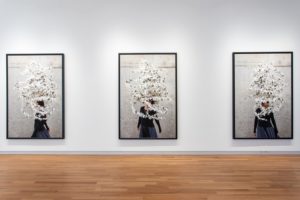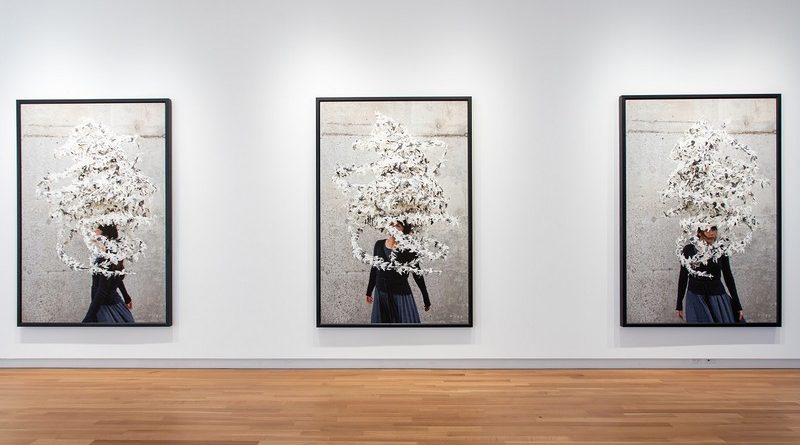Gallery Scene/Seen
New Indigenous art in Sandy Hill
Maureen Korp
Over the last few years, at very many public gatherings, talks, and meetings in Ottawa, people have grown accustomed to hearing proceedings open with a courteous acknowledgement expressing gratitude to the Algonkian peoples whose unceded lands these are. But what does that mean, really? What is it people know of this history, of these living, vital traditions? Take a walk across the University of Ottawa campus. A new sculpture commissioned by the university presents one answer.
On the lawn in front of Tabaret Hall is a monumental sculpture by David General, an artist of Oneida-Mohawk heritage. It is a dynamic figure of polished granite. In this work, the artist makes three planes of knowledge visible. Entitled “She dances with the earth, water, and sky,” the sculpture is an image of movement and connection – upper world, lower world, this world. The animals, all creatures with their own tales to tell of human-trickster interaction, watch the sweep of her dance. We may hope students walking across the lawn are watching, too.
The sculpture bears an identification plaque stating in three languages – English, French, and Anishinaabemowin – this work by David General was “commissioned to represent the relationship founded on truth and reconciliation between uOttawa and the Omamiwinini Anishinabeg on whose land this campus was built.”

Photo Chris Snow
There are few public sculptures anywhere in the sprawl of Ottawa which address our shared histories. There are, from time to time, art exhibitions that do. Across the street from the University of Ottawa is an important new exhibition at the Ottawa Art Gallery: “Inaabiwin,” curated by Danielle Printup and the Robert McLaughlin Gallery. Here you will see the work of five indigenous Canadian visual artists, and one Canadian poet. Give yourself a quiet hour to look and look again at the work of all. “Inaabiwin,” an Anishinaabemowin word, denotes seeing, seeing with insight and understanding. “Inaabiwin” is a skill learned by watchfulness and attentiveness. It is the skill of the artist, certainly. It is also knowledge imparted by elders. “Inaabiwin” enables us to know the importance of an event, of here, now, and then.
The exhibition “Inaabiwin” is presented in four rooms. In the first room, a 12- minute film by Tanya Lukin Linklater entitled “The Treaty is in the Body,” 2017, is screened on one wall. There is no sound, no background melody. The film is a visual exercise portraying the instruction of elders showing children how to dance, how to watch small animals, how to move like them. The children also learn to bead, braid, give and receive sweetgrass blessings. Linklater has made her film in bits and pieces.
As viewers, we are meant to keep our eyes moving in order to see a bit of here, there, then over there. We were born with the scanning vision of hunters: our eyes are in the front of our heads. This is also the wisdom shared by the elders in the room Linklater documents. In front of the old women is a coffee table neatly piled with art books by famous artists, but that would be another story, surely.
In the second room of the exhibition, “Water Song,” 2014, by Hannah Claus, is hung as a series of nine floating forms, groupings of reflective discs of the softest colours. They float up, down, around, within three planes of movement, three levels of reality: upper, lower, and wider at midpoint. Their float, however, moves them into a fourth dimension, time.

Photo Chris Snow
Three planes of movement are also seen in “Murmur,” 2013, a series of three large self-portrait photographs by Meryl McMaster. In each we see a dancer. She moves within and under a large sculpture of birds, all flying somewhere, up, down, around – the whole of it inspired by the artist’s study of a murmuration of starlings. Each bird was folded of scrap paper – now become thoughts flown into thin air.
“Requickening Address,” 1994, by Greg Staats is a series of 15 toned silver gelatin prints, quite small, each mounted on board with wampum strings. There is a quiet rhythm within the whole. Take a long slow walk along the wall where they are hung, then walk back again. Nothing ever ends, all transform. As one title reminds, “11. The council fire rekindles the peace.”
In the third room is a short, three-minute video by Scott Benesiinaabandan. “Psychic History (home Montreal) + Blood Memories,” 2013, is a dynamic work. In short, lighter, darker bits (scanning vision, remember), we see ridge lines, hanging forms, turkey feet.
The last room of “Inaabiwin” displays a poem, “The earth ringing in my chest,” hung as a curtain along two walls. The work is by Billy-Ray Belcourt and was written in response to the artists’ work of “Inaabiwin.” Beside the hanging is a large window. Through it one sees downtown Ottawa. It all looks different somehow.
The Ottawa Art Gallery is presenting “Inaabiwin” in conjunction with the National Gallery of Canada’s new international exhibition of Indigenous art, “Abadakone/Continuous Fire.” “Inaabiwin” continues until January 19, 2020.
Other exhibitions of interest in Ottawa
To January 29 2020:
Art + Parcel (A Holiday Art Show)
To February 9 2020:
Facing Claude Cahun and Marcel Moore
Both at Ottawa Art Gallery, 50 Mackenzie King Bridge, Ottawa
Free. 9 am – 9 pm every day
To January 29 2020:
City of Ottawa art collection: 2019 additions
Karsh-Masson Gallery and City Hall Art Gallery
